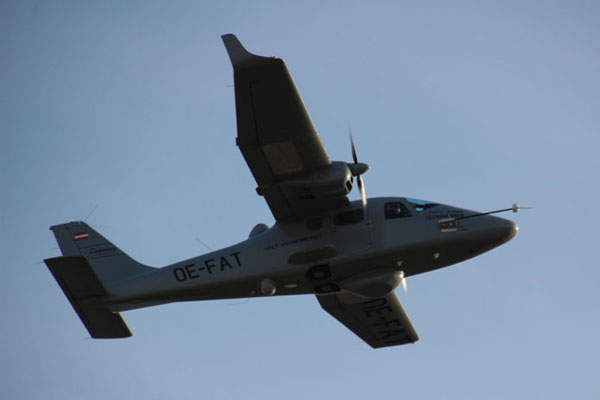
P2006T MRI (Maritime Reconnaissance Intelligence) is a maritime surveillance version of the P2006T aircraft. The aircraft was designed and developed by Indra. The P2006T MRI is intended to conduct maritime operations between 50nmi and 200nmi at very low acquisition and operational costs.
The P2006T MRI is ideal for missions such as maritime safety, search-and-rescue (SAR), fisheries protection, marine environmental protection, offshore oil fields protection, drugs and illegal immigration interdiction, defence readiness and law enforcement.
The test programme of the P2006T MRI was launched in March 2012. The aircraft completed a series of test flights in early 2013.
P2006T MRI design
The MRI is based on the Tecnam P2006T aircraft. The high-wing design of the MRI version provides stability, comfort and superior visibility. The structural design of cabin meets the requirements of FAR23 and CS23 crash-worthiness amendments. The robust yet lighter airframe of P2006T provides a higher payload carrying capacity.
The aircraft measures 8.7m in length and 2.85m in height. The length and width of the cabin are 3.35m and 1.22m respectively. The P2006T MRI has the maximum take-off weight of 1,230kg.
Cockpit of P2006T MRI
The cockpit of the P2006T MRI integrates the Garmin G950 avionics suite, autopilot, synthetic vision display (SVD), Stormscope weather mapping system, and distance measuring equipment (DME).
The G950 is an all-glass avionics suite that can include two or three displays providing primary flight characteristics, pilotage, terrain and traffic information, weather and engine data. The other features include attitude and heading reference system (AHRS), Mode S transponder, engine-monitoring display and air data computer.
Sensors/radars aboard P2006T MRI
The aircraft is equipped with SELEX Galileo Seaspray 5000E active electronically scanned array (AESA) multi-mode surveillance radar. The lightweight system includes just two line replaceable units (LRUs) and can be easily integrated with other mission sensors and avionics.
The FLIR Systems Ultra Force 275 HD electro-optical system consists of infrared sensor and high definition colour camera delivering digital HD imagery for all video channels.
P2006T MRI mission system
The core element of the P2006T MRI is the mission system integrating all information gathered by multiple sensors aboard the aircraft. The system controls the onboard sensors and handles the communication with the ground support station (GSS). The GSS is an inherent component of the airborne surveillance system.
The mission system employs radar search sequences to find and locate the targets. The automatic identification system (AIS) transponder aboard the P2006T MRI is interfaced with the radar to identify the targets carrying AIS transceivers. The SAR/ISAR modes can be deployed to sort out the unidentified targets, while the identification of the targets is ensured by the electro-optical system.
The information is demonstrated graphically over a map display. The data, which is generated, can be recorded and transmitted in real time to the GSS through the IP-based line of sight (LOS) data link. The data link allows bidirectional communication between the aircraft and the GSS. The operator aboard the aircraft receives the data from the ground station personnel and all the information is recorded for future reference.
Engines and landing gear of the MRI aircraft
The P2006T MRI is powered by two four-cylinder four-stroke Rotax 912S3 liquid cooled engines driving two two-bladed MTV-21 propellers. Each engine develops a power output of 100hp (73kW) and has a time between overhaul (TBO) of 2,000 hours. The twin-engine configuration ensures the aircraft to reach long distances over water or terrain.
The fully retractable landing gear allows the installation of multiple sensors under the fuselage. The very short takeoff/landing (STOL) capability of the aircraft ensures operations on short runways.
Performance of the P2006T MRI
The Tecnam P2006T MRI can fly at a maximum speed of 140kt. It can climb at a rate of 1,190ft/min for a maximum altitude of 14,000ft. The aircraft has a range of 500nmi. Its two fuel tanks, with a total capacity of holding 200L, provide an endurance of six hours.
The Global Military Aircraft Market 2011-2021
This project forms part of our recent analysis and forecasts of the global military aircraft market available from our business information platform Strategic Defence Intelligence. For more information click here or contact us: EMEA: +44 20 7936 6783; Americas: +1 415 439 4914; Asia Pacific: +61 2 9947 9709 or via email.
Related content
A319 MPA Maritime Patrol Aircraft, Spain
The A319 MPA is a long-range maritime patrol and ASW aircraft developed by Airbus Military.
Atlantique ATL3 Maritime Patrol Aircraft, France
The Atlantique ATL3 maritime patrol aircraft, successor to the Atlantique ATL1 and ATL2, incorporates an enhanced weapon system with a maximum 9,000kg payload, new technology engines, glass cockpit and sophisticated avionics and sensors.








.gif)
